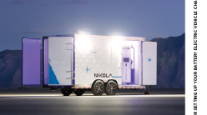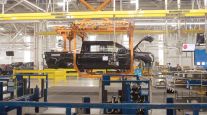Staff Reporter
Electrified Fleet Grid Upgrades Could Benefit Utilities

[Stay on top of transportation news: Get TTNews in your inbox.]
Paying for power grid upgrades trucking companies need to charge electrified medium- and heavy-duty fleets would provide a long-term financial boon to utilities, and just as importantly, would not increase rates for electricity customers, a recent study found.
Utilities, regulators and rate payers across the United States cannot hide behind the cost argument when it comes to socialized funding of the grid upgrades needed for widespread electrification of medium- and heavy-duty trucking, according to the analysis, commissioned by nongovernmental group Environmental Defense Fund.
Currently, the costs of these upgrades fall largely on individual fleet owners. This may hinder electrification, especially for fleet owners who already face challenging economics in electrifying their fleets.
Carried out by consultants at Synapse Energy Economics, the analysis warns that upgrading the electrical infrastructure required to make a commercial site ready for EV charging, known as “make-ready,” can account for up to 30% of the total cost of charging for fleets.

Musgrave
“The charging is the hardest part, having utility make-ready programs are vital for fleets having successful electric vehicle deployment,” Dependable Highway Express Director of Process Improvement Troy Musgrave told Transport Topics May 1.
Dependable Highway Express is a unit of Dependable Supply Chain Services, which ranks No. 83 on the Transport Topics Top 100 list of the largest for-hire carriers in North America.
Synapse’s study shows that if utilities cover the make-ready cost for both private and municipal fleets, the investment will pay off for those electricity providers and have a positive to neutral impact on ratepayers in both utility service areas.
The analysis investigated how Con Edison and National Grid — New York utilities with wildly different service territories when it comes to grid costs, electricity demand profiles and landscape — would fare if they took on the make-ready costs. Con Edison serves New York City. National Grid provides electricity to the more rural upstate New York.
Under a “managed charging” scenario, Con Edison’s make-ready program generates $1.1 billion in net revenue between 2023 and 2045, while National Grid’s program generates $141 million in the same time period, the study found. Managed charging aligns EV charging with the greatest availability of more affordable electricity and also reduces stress on the larger grid.
Our analysis for the @EnvDefenseFund addresses the necessity of reducing vehicle emissions & the need for grid updates. The analysis uses two NYC utility case studies to find that grid updates don't necessarily lead to higher consumer electricity rates. https://t.co/anlU0Tqd7v — Synapse Energy (@SynapseEnergy) April 19, 2023
Even without managed charging, investing in make-ready programs was shown to have a positive to neutral impact on ratepayers in both utility service areas, according to the study. The analysis also sees a virtuous circle forming, arguing that as more fleets are incentivized to plug in — thereby buying more electricity — utilities can invest a portion of their returns on grid upgrades elsewhere that would have otherwise been paid for by all ratepayers.
“Investing in make-ready programs can benefit fleets, utilities and consumers,” said Pamela MacDougall, grid modernization director at EDF. “When paired with clear targets, like the Advanced Clean Truck rule, make-ready investments can help states achieve their climate goals and accelerate the transition to a zero-emission future.”
One trucking industry observer sees such a concept as a win-win option for utilities and trucking companies and agrees with the study’s findings. North American Council for Freight Efficiency Executive Director Mike Roeth told TT that the dollars on offer to utilities to replace oil were too tempting and said he was a bit surprised utilities weren’t leaning into it a little bit harder.
Electrifying trucks is hard, but so is using diesel, Roeth said in a phone interview April 28, adding there’s a lot of electricity to be sold in any shift to electrification.

Roeth
Such projects are a lot of work for utilities, and while the prospect of electrification has been mooted on previous occasions, this time it is different, Roeth said. He said that is because there is less chance of a reversal or buyer’s regret from fleet owners, as confidence about a return to historically low diesel prices dissipates, the momentum from regulators seeking change is growing, and the drive for sustainability from the public and boardrooms is soaring.
Utilities back the concept too. “Con Edison stands ready to accelerate the transition to clean transportation,” Raghu Sudhakara, Con Edison’s vice president of distributed resource integration, said in a statement. “Infrastructure and make-ready investments not only allow for customers to choose electric transportation and reduce pollution and noise in our communities, but will also help in moderating electricity rates in the longer term.”
EDF’s MacDougall said the main pushback has been from ratepayer advocates. However, the study shows there will be a neutral or positive impact on rates and electrification of trucking won’t drive up rates for customers, she said.
Reducing greenhouse gas emissions from medium- and heavy-duty trucks will be necessary for the United States to meet its climate goals and will involve electrifying the majority of these vehicles, according to the Synapse researchers.
California was at the center of such efforts over the past couple weeks. The California Air Resources Board on April 28 unanimously approved its Advanced Clean Fleets regulation, which will require some motor carriers operating in the state to begin the transition to zero-emission trucks as soon as 2024.
CARB’s goal is to have fleets operating in the state be 100% electric by 2035, 2040 or 2045, depending on size and type of truck. Drayage trucks will be required to start transitioning to zero-emission technology beginning in 2024, with full implementation by 2035.
Industry efforts are underway to scale up electric truck use and infrastructure in California too. NACFE’s Run on Less program in September will focus on scaling electric trucks across a variety of market segments, it said April 26. The program will have a decidedly California feel, as seven of the eight fleets participating in the demonstration are based in the Golden State.
Want more news? Listen to today's daily briefing above or go here for more info
Also, Daimler Truck North America, Juno Beach, Fla.-based utility NextEra Energy Resources and fund manager BlackRock on April 27 unveiled a joint venture to design, develop, install and operate a U.S. nationwide, high-performance zero-emission public charging and hydrogen fueling network for medium- and heavy-duty battery-electric and hydrogen fuel cell vehicles.
The first sites for the $650-million commercial vehicle charging infrastructure JV, known as Greenlane, will be in Southern California. Down the line, a network of charging sites will be built on critical freight routes along the east and west coasts and in Texas, Greenlane’s backers said.
Most commercially available fast-charging stations currently enable power levels ranging from 250-350 kW. Recent studies of requirements for regional and longhaul truck operations in the U.S. and Europe find that charging capabilities above 350 kW, and as high as 1 MW, may be required to fully recharge electric trucks during a 30- to 45-minute break, according to a report issued April 26 by the International Energy Agency.
In 2019, medium- and heavy-duty vehicles accounted for over one-fifth of U.S. transportation sector emissions, equivalent to 7% of total U.S. greenhouse gas emissions, according to the National Renewable Energy Laboratory.




